Trail Camera Noise: Part 2 — Ultrasonic Squeals
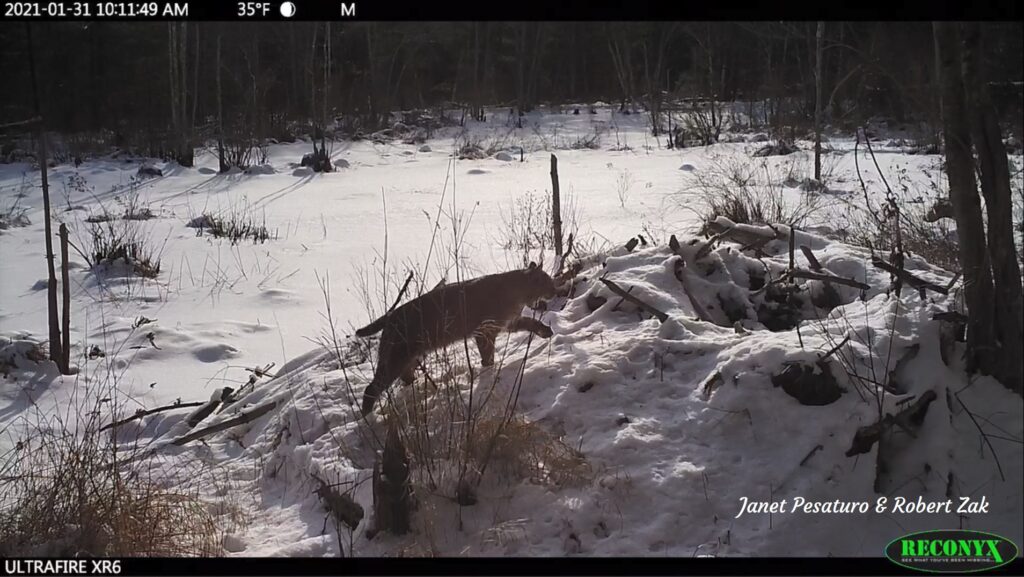
Animals are sometimes startled by trail cameras as the cameras are taking photos and videos. Camera noise seems a likely culprit, especially in daytime captures, without the flash. In Part 1 of this two part series, I listened carefully to the “clicks” made by the IR filter in most cameras. In this Part 2, I assess ultrasonic noise, or “squealing” made by some trail cameras. I describe a simple and inexpensive test setup that I used in our basement and in the field for recording camera noise. I report on results from 8 cameras from multiple vendors. The good news is that there is evidence that manufactures are making their cameras practically noiseless in the ultrasonic range.
What Do Animals Hear?
Many animals can hear sounds beyond the range of human hearing. Meek et al (see References) report on the frequency sensitivity of several animal species. In general, the smaller the animal, the more likely it is to be sensitive to higher frequencies. For example, see Janet’s post on Grasshopper Mice, featuring a ~12 kHz “howl”. The table below lists hearing range for a selection of mammal species.
| Animal | Upper Range of Hearing (kHz) |
| Elephant | 12 |
| Human | 23 |
| Sheep | 30 |
| Horse | 33 |
| Cow | 35 |
| Raccoon | 40 |
| Northern Quoil | 40 |
| Ferret | 44 |
| Dog | 45 |
| Hedgehog | 45 |
| Rabbit | 49 |
| Fox Squirrel | 49 |
| Guinea Pig | 50 |
| Wood Rat | 56 |
| Black Bear | 60 |
| Kangaroo Rat | 62 |
| Cat | 64 |
| Oppossum | 64 |
| Grasshopper Mouse | 69 |
| Cotton Rat | 72 |
| Rat | 76 |
| Brush Tailed Possum | 88 |
| House Mouse | 92 |
| Bat | 110 |
Ultrasonic Trail Camera Noise
By definition, ultrasonic noise is beyond the range of human hearing — as high as 23 kHz for the younger individuals of our species, but typically around 12 kHz for their parents, and 6 kHz for their grandparents. To measure this sound, we will need some instrumentation.
I used an AudioMoth Acoustic Data Logger featured in an earlier post (see: Using an Acoustic Logger to Capture Wildlife Sounds) to record sound from trail cameras and background noise.
I made high definition recordings of various camera models in laboratory and (in one case) a field environment. The recordings included audio before, after, and during camera trigger. I used audio analysis tools and a spreadsheet to look for differences — especially in the ultrasonic end of the spectrum. The Appendix at the end of this post contains the details of the setups and examples of measurement data.
Below is a video I made which combines audio from an acoustic logger before, during, and after a Reconyx XR6 captures a video of a deer browsing in tall grass. I didn’t detect any noise (ultrasonic or otherwise) from this camera in field conditions. See Appendix for details.
Summary by Camera Make and Model
The table below summarizes results for ultrasonic noise from various cameras in our collection along with the “click” data from Trail Camera Noise: Part 1. A couple of the models emit faint but measurable noise in the ultrasonic spectrum. For reference, 20 dB is characterized as “below a whisper (30-40 dB), on par with rustling leaves”. In more recent models, even this faint ultrasonic noise has been eliminated.
| Manufacturer | Model | Ultrasonic Noise Range | IR Filter “Click” |
| Browning | Recon Force FHD Platinum (BTC-7FHD-P) | ~20 dB at ~21 and 57 kHz | Yes |
| Recon Force Advantage (BTC-7A) | None Detected | Yes | |
| Spec Ops Advantage (BTC-8A) | None Detected | Yes | |
| Exodus | Lift 1 | ~20 dB at 20-50 kHz | Yes |
| Lift 2 | None Detected | Yes | |
| Foxelli | 14 MP FULL HD TRAIL CAMERA (DL1) | None Detected | Yes |
| Moultrie | D900i | ~20 dB at 10-50 kHz | Yes |
| Reconyx | UltraFire Professional Covert (WP9) | (Not yet measured) | No |
| UltraFire Covert (XR6) | None Detected | No |
Conclusion
I found some trail cameras in our collection produced faint noise in the ultrasonic spectrum. But, the most recent models, from several modern cameras, from different vendors, are as quiet as mice.
Regarding the bobcat in the title image: the Reconyx XR6 neither emits ultrasonic noise, nor a “click” from an IR filter motor. This no doubt helps explain the candid hunting shot.
Do you suspect your trail camera of making ultrasonic noise? Let me know, in comments below.
References:
- Meek PD, Ballard G-A, Fleming PJS, Schaefer M, Williams W, Falzon G (2014) Camera Traps Can Be Heard and Seen by Animals. PLoS ONE 9(10): e110832. : A terrific paper covering both sounds and light made by trail cameras, and including sensitivity of different species to sound and light frequencies. This blog post follows up on the “sound” aspect for a different (newer) set of trail camera models.
- Audacity: Free, open source, cross-platform audio software. Processes the raw audio files, and generates diagnostic spectrograms, and can make bat echolocation calls audible by shifting ultrasonic sounds into the human audible frequency range. And much more.
- Open Acoustic Devices: Makers of Audiomoth, a low-cost, full-spectrum acoustic logger described in this blog post.
Appendix: Experimental Setup and Detailed Data Results
Field Setup
I wanted to get some sense of camera behavior in the field. I placed the AudioMoth unit directly under a Reconyx XR-6 trail camera and lock box in a sturdy, waterproof plastic zip-lock bag. The camera was anchored to a tree and pointed at an abandoned, caved-in beaver lodge.
I set the sample rate for the AudioMoth to 96,000 samples per second, for a discernable (Nyquist) frequency limit of 48kHz. I used a lower sample rate so that I could capture more hours of recording, while still being able to capture ultrasonic noise up to 48 kHz. With a 64 GB microSD card, the AudioMoth recorded nearly 3-days of continuous audio. I set the “gain” to “medium”.
Field Test Procedure
With the AudioMoth set to record continuously, I counted on an animal triggering the camera while the acoustic logger was still recording (within a three days of us setting up the camera and audio recorder). I use the synchronized time between the camera and the audio recorder and the time stamp on the trail camera video to find the spot in the (very long) audio recording where the audio and video overlapped. This allowed me to make two measurements:
- Compare the sound recorded before and after the camera triggered with the sound recorded while the camera was active to see if I could detect any ultrasonic camera noise (the XR7 has two image sensors, and therefore no IR filter, and no “clicking”)
- Compare the audio recorded by the camera to the audio recorded by the AudioMoth to see if there were any audio artifacts (spurious clicks or buzzes) in one or the other.
Field Results
I was fortunate that a deer stopped by to trigger the camera while the AudioMoth was still recording. The video of a deer earlier in this post is of this encounter, with audio before and after the trail camera video as recorded by the AudioMoth acoustic logger. I used my video editing software to combine the audio from the camera and the audio from the AudioMoth in the middle of the video.
AudioMoth/Trail Camera Comparison
Spurious Noise?
Focusing on the clip of the deer captured by the Trail Camera, I found no evidence of any artifactual audio from the camera. That is, the audio from the trail camera and from the AudioMoth were virtually identical. Thus, there is a slight “stereo” effect when the audio is combined, but no significant differences.
Spectra
I used Audacity to create spectrograms of audio recorded before and after the camera triggered (Camera Off and Camera On, respectively). I used Excel to plot the difference (Delta) between these two. In the graph below, the only difference in spectra is in the audible range and reflects actual differences in the recorded sound (i.e. the movement of the deer through the grass). The rustling of the dry grass creates some high frequency content, up to about 25kHz. Per other measurements with the AudioMoth, the AudioMoth itself introduces an artifact in the data at around 32 kHz which is present with or without the camera on.
There is no difference between camera being on, or not, in the high frequency content, and thus we can conclude that the XR-6 is not emitting any ultrasonic “squeals”. This seems consistent with the behavior of the deer, which does not seem to take any notice of the camera or change its grazing behavior.
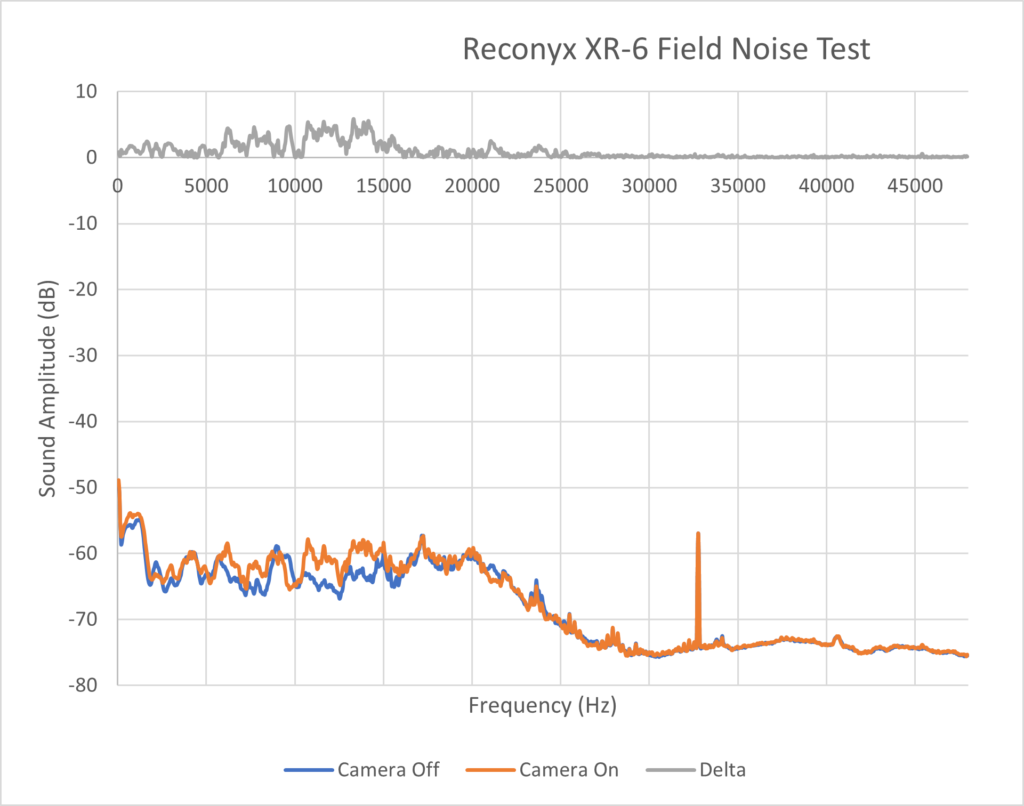
Lab Setup
I set the sample rate for the AudioMoth to the maximum of 384,000 samples per second, for a discernable (Nyquist) frequency limit of 192kHz. I set the “gain” to “maximum” and placed the unit 10 cm away from the trail camera under test with the microphone port pointing directly at the camera.
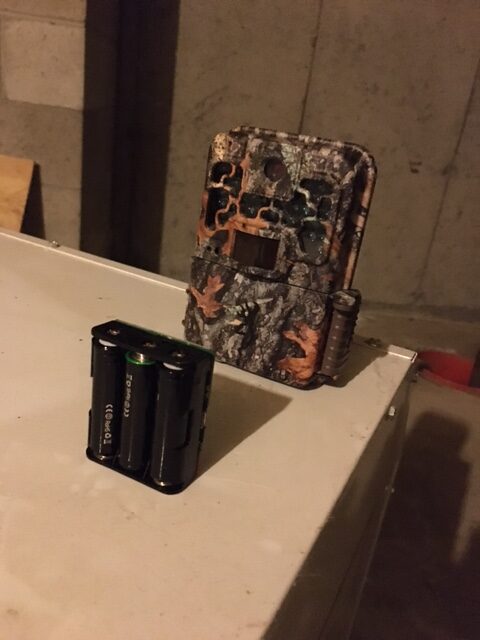
I performed tests in a quiet place (my basement) in which I eliminated obvious sources of noise. Even so, this was hardly an acoustic chamber, with recordings containing the rustle of my clothes, as well as background noises of low flying airplanes, occasional traffic, and faint household sounds. In the data analysis, I am able to “subtract” out this “baseline” noise to show the noise generated by the camera.
Lab Test Procedure
I performed a test for each camera in which I record:
- a start-of-test baseline (no camera),
- a series of “trigger events” in which the camera and flash are active
- an end-of-test baseline.
I annotate the recordings with my own voice, creating a self-contained experimental record.
The camera is triggered by passing my hand in front of the PIR sensor (but behind the audio recorder) as quietly as I can.
I used Audacity to post-process the .WAV files and to generate spectrograms (frequency content vs. time plot) of the experiment. I also used Audacity to create spectra of the “active” and “baseline” cases. Finally, I used Excel to create a “delta” or “difference” spectrum, which represents the net noise of the camera.
Lab Results
Spectrograms
Below are two examples of the spectrograms generated for two cameras –one which emits ultrasonic noise when active (Moultrie D900i), and one which does not (Browning Recon Force Advantage — BTC-7A).
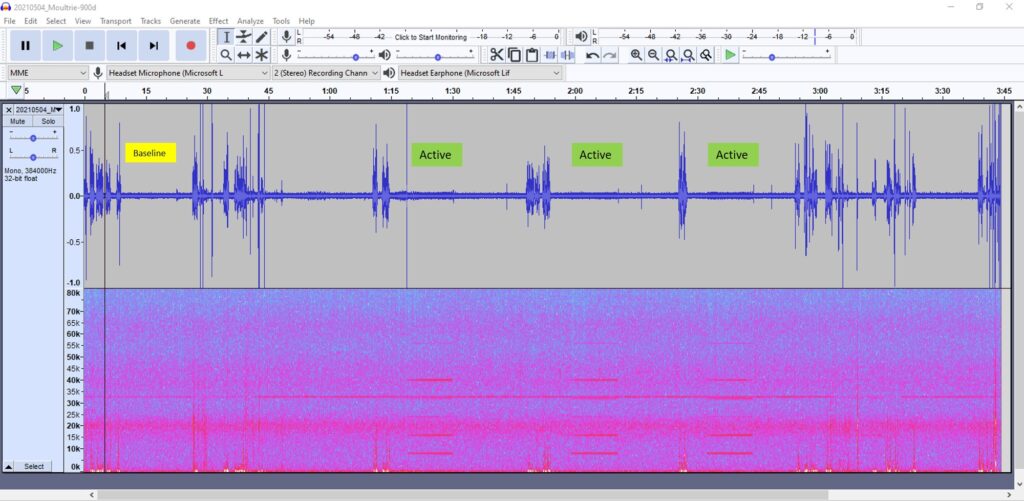
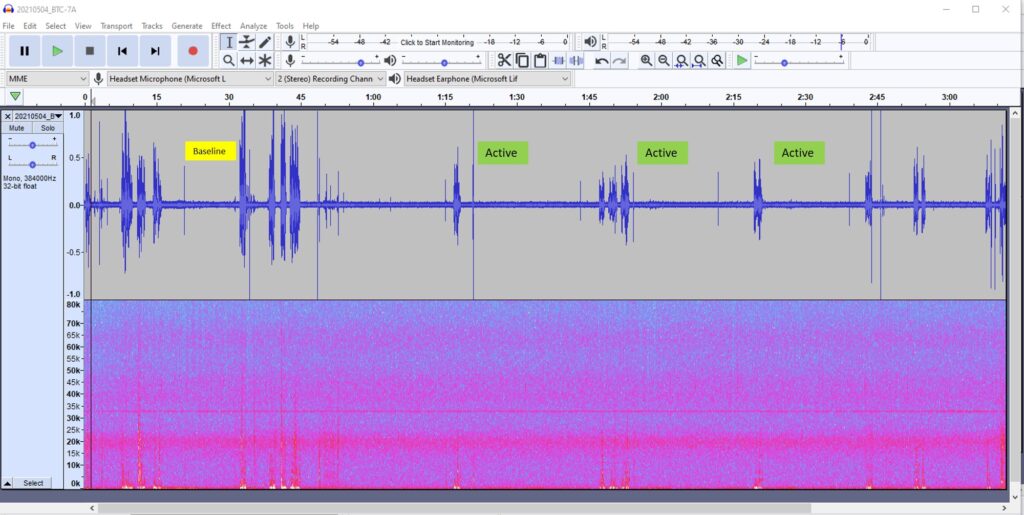
A look at a typical baseline recording shows clear limitations of this equipment and experimental setup. We must consider as “artifacts” (non-trail camera induced noise) apparent spectral content at 32 kHz. Likewise, the more disperse background noise in bands around 20, 40, and 60 kHz.
Yet, despite these sources of experimental background noise, the spectrogram shows clearly (or not) the signatures of the cameras under test. The red “ladders” during the active phases in the Moultrie D900i spectrograms indicates noise from the camera at ~8 kHz intervals from ~10 – ~40 kHz. In contrast, the spectrogram of the BTC-7A is remarkably uniform across baseline and active epochs, indicating that this camera is not squealing.
Spectra
I also used Audacity to generate spectra for baseline and active periods during the tests of the camera. Below are two examples of spectra plots from two cameras — one which emits ultrasonic noise when active (Exodus Lift 1), and one which does does not (Exodus Lift 2). These plots include the “Delta” spectra — which is the net noise (Active – Baseline) generated by the camera.
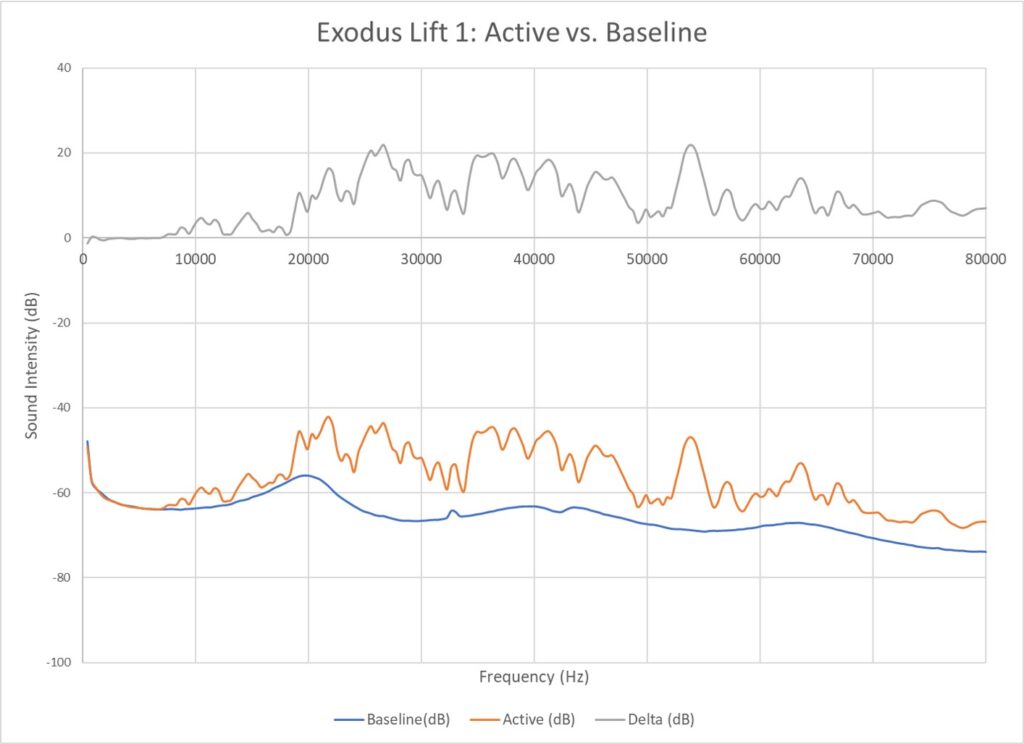
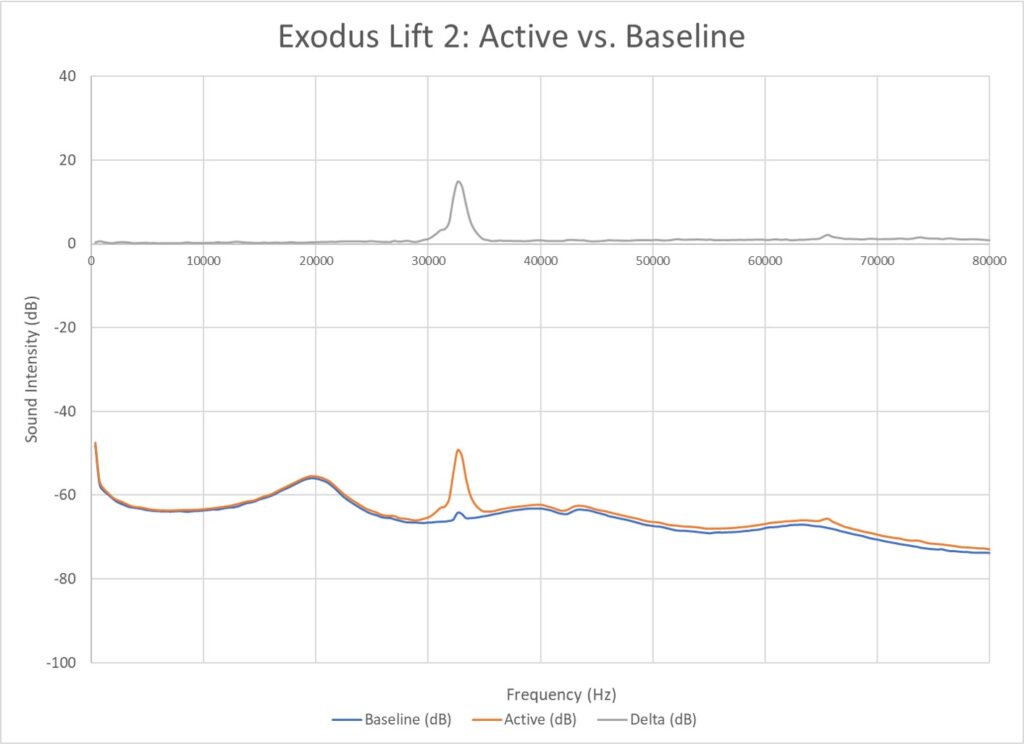

I have often wondered why field mice and woodrats would stare at the camera. Now I wonder if they hear it rather than see it.
Certainly with one of the cameras I found to be noisy, it’s a good possibility!
Great information! I was fortunate that a deer stopped by to trigger the camera while the AudioMoth was still recording.
Thank you
Yes. This was a familiar set, so I knew the odds were in my favor for some animal visiting in the couple of day period that the AudioMoth was working. Still, I was lucky that one actually did. Glad you found this info useful, and thanks for close read 🙂